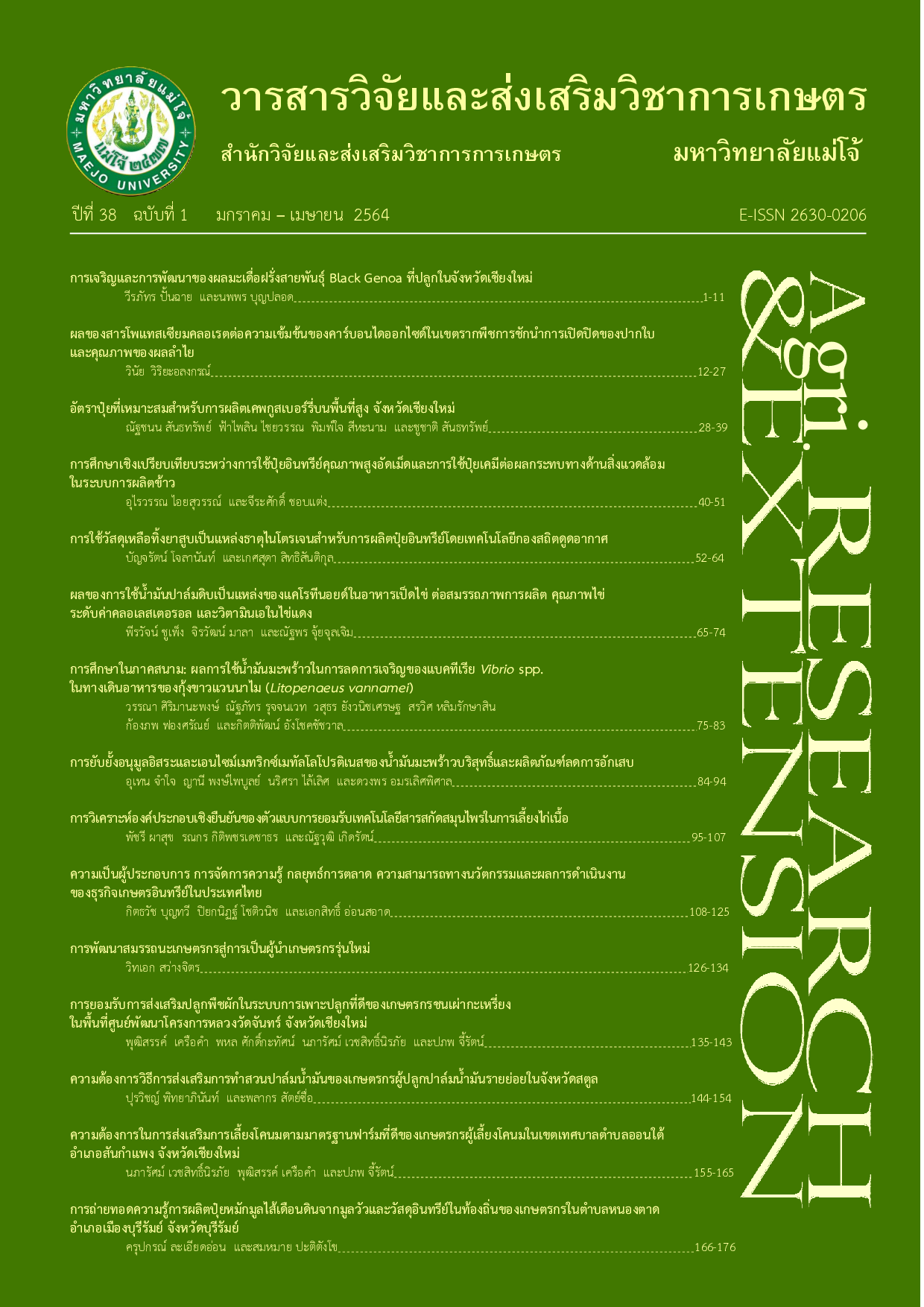การเจริญและการพัฒนาของผลมะเดื่อฝรั่งสายพันธุ์ Black Genoa ที่ปลูกในจังหวัดเชียงใหม่
คำสำคัญ:
Ficus carica L., double sigmoid curve, คุณภาพผลบทคัดย่อ
การศึกษาการเจริญและการพัฒนาผลมะเดื่อฝรั่ง (Ficus carica L.) พันธุ์ Black Genoa ดำเนินการ ณ แปลงทดลองไม้ผล สาขาไม้ผล คณะผลิตกรรมการเกษตร มหาวิทยาลัยแม่โจ้ จังหวัดเชียงใหม่ ระหว่างระยะเวลา ตั้งแต่เดือน ธันวาคม พ.ศ. 2561 ถึงมีนาคม พ.ศ. 2562 ที่พื้นที่ระดับน้ำทะเล 322 เมตร โดยมีวัตถุประสงค์เพื่อให้ได้ข้อมูลลักษณะการเจริญและการพัฒนาผลมะเดื่อฝรั่ง สามารถใช้เป็นแนวทางในการพัฒนาคุณภาพผลผลิตต่อไป โดยคัดเลือกต้นมะเดื่อฝรั่งที่สม่ำเสมอกัน จำนวน 10 ต้น คัดเลือกช่อดอกของมะเดื่อฝรั่งจำนวน 120 ช่อดอก/10 ต้น จากนั้นทำการสุ่มเก็บผลสัปดาห์ละ 5 ผล ภายใน 10 ต้น เพื่อเก็บข้อมูลการเจริญเติบโต และคุณภาพของผลได้แก่ น้ำหนักผล, ความกว้างผล, ความยาวผล, ปริมาณของแข็งที่ละลายน้ำได้, ปริมาณของกรดที่ไทเทรตได้, ความแน่นเนื้อ และ สีผิวของผล พบว่า การเจริญของผลมะเดื่อฝรั่งมีลักษณะการเจริญเติบโตเป็นแบบ double sigmoid curve คือ ในระยะแรก สัปดาห์ที่ 1-4 มีน้ำหนักเฉลี่ย 0.01-0.44 กรัม, ความกว้างเฉลี่ย 1.89-6.60 ;มิลลิเมตร, ความยาวเฉลี่ย 2.03-10.17 มิลลิเมตร ระยะที่สอง สัปดาห์ที่ 5-8 มีน้ำหนักเฉลี่ย 0.74-11.59 กรัม, ความกว้างเฉลี่ย 12.85-31.6 มิลลิเมตร, ความยาวเฉลี่ย 21.48-50.66 มิลลิเมตร ระยะที่สาม สัปดาห์ที่ 9-12 มีน้ำหนักเฉลี่ย 12.97-69.39 กรัม, ความกว้างเฉลี่ย 33.21-40.94 มิลลิเมตร, ความยาวเฉลี่ย 52.57-62.79 มิลลิเมตร ด้านปริมาณของแข็งที่ละลายน้ำได้เฉลี่ย สัปดาห์ที่ 6-12 อยู่ที่ 6.30-17.80 ºBrix, ปริมาณของกรดที่ไทเทรตได้ สัปดาห์ที่ 6-12 อยู่ที่ 0.19-0.23%, ความแน่นเนื้อ สัปดาห์ที่ 6-12 อยู่ที่ 1.4-0.1 kg/cm2 และสีผิวของผลผลจะเริ่มเปลี่ยนสีจากสีเขียวไปเป็นสีเหลืองในสัปดาห์ที่ 10 และจะเปลี่ยนเป็นสีแดงอมม่วงจนถึงสีม่วงดำในสัปดาห์ที่ 12 ตามลำดับ
เอกสารอ้างอิง
Abo-El-Ez, A.T., R.A.A. Mostafa and I.F. Badawy. 2013. Growth and productivity of three fig (Ficus carica L.) cultivars grown under upper Egypt conditions. Australian Journal of Basic and Applied Sciences 7(2): 709-714.
Biale, J.B. 1961. The postharvest biochemistry of tropical and subtropical fruits. Advances in Food Research 10: 293-354.
Botti, C., N. Franck, L. Prat, D. Ionnandis and B. Morales. 2003. The effect of climatic conditions on fresh fig fruit yield, quality and type of crop. Acta horticulturae DOI: 10.17660/ActaHortic.2003.605.4. 37-44.
Brummell, D.A. 2010. Fruit Growth Ripening and Post-harvest Physiology. pp. 1-50. In Bieleski, R.L. I.B. Ferguson and E.A. MacRae (eds.). Plants in Action. 1st Edition. Australia: Plant Science Societies, Australian Society of Plant Scientists.
Chairauengyoth, T. 2019. Khun Lee's garden and planting figs in Thailand. [Online]. Available https://www.technologychaoban.com/bullet-news-today/article_97008. (25 January 2020). [in Thai]
Crane, J.C. and J.G. Brown. 1950. Growth of the fig fruit, Ficus carica var. Mission. American Society for Horticultural Science 56: 93-97.
Crisosto, C.H., V. Bremer, L. Ferguson and G.M. Crisosto. 2010. Evaluating quality attributes of four fresh fig (Ficus carica L.) cultivars harvested at two maturity stages. HortScience 45(4): 707-710.
Dokoozlian, N.K. 2010. Grape berry growth and development. Raisin Production Manual 3393:30.
Ersoy, N., S. Gozlekçki and L. Kaynak. 2007. Changes in sugar contents of fig fruit (Ficus carica L. cv. Bursa Siyahi) during development. Suleyman Demirel Universitesi Ziraat Fakultesi Dergisi 2(2): 22-26.
Hatami, M., S. Kalantari and M. Delshad. 2012. Responses of different maturity stages of tomato fruit to different storage conditions. VII International Postharvest Symposium 1012: 857-864.
Heng, H.T. 2019. Figs are trending in Southeast Asia. [Online]. Available https://www.mintel.com/blog/food-market-news/figs-are-trending-in-southeast-asia (11 August 2020). [in Thai]
Kulkarni, A.P. and S.M. Aradhya. 2005. Chemical changes and antioxidant activity in pomegranate arils during fruit development. Food Chemistry 93(2): 319-324.
Moing, A., C. Renaud, M. Gaudillère, P. Raymond, P. Roudeillac and B. Denoyes-Rothan. 2001. Biochemical changes during fruit development of four strawberry cultivars. Journal of the American Society for Horticultural Science. 126(4): 394-403.
Nilsamranchit, S., J. Thongtham and P. Punsri. 1985. Growth of the Common Fig (Ficus carica L.) Grown on the Highlands of Thailand. pp. 258-266. In Proceedings of the 23rd Kasetsart University Meeting 4-7 February 1985. Bangkok: Kasetsart University. [in Thai]
Owino, W.O., R. Nakano, Y. Kubo and A. Inaba. 2004. Coordinated expression patterns of genes encoding cell wall modifying enzymes during ripening in distinct anatomical regions of the fig (Ficus carica L.) fruit tissue. Postharvest Biology and Technology 32: 253-261.
Phiphatthanawong, N. 2007. Temperate Small Fruits Production in Tropical Zone. Bangkok: Kasetsart University Press. 176 p. [in Thai]
Polat, A.A. and O. Caliskan. 2008. Fruit characteristics of table fig (Ficus carica L.) cultivars in subtropical climate conditions of the Mediterranean region. New Zealand Journal of Crop and Horticultural Science 36(2): 107-115.
Prabthuk, W. 2016. Tree Arrangement and Pruning of High Trees Fruit. Chiang Mai: Highland Research and Development Institute (Public Organization). 141 p. [in Thai]
Puechkaset. 2016. Figs (Fig): Properties and cultivation of figs. [Online]. Available https://puechkaset.com/%E0%B8%A1%E0%B8%B0%E0%B9%80%E0%B8%94%E0%B8%B7%E0%B9%88%E0%B8%AD%E0%B8%9D%E0%B8%A3%E0%B8%B1%E0%B9%88%E0%B8%87/ (25 January 2020). [in Thai]
Rooban, R., M. Shanmugam, T. Venkatesan and C. Tamilmani. 2016. Physiochemical changes during different stages of fruit ripening of climacteric fruit of mango (Mangifera indica L.) and non-climacteric of fruit cashew apple (Anacardium occidentale L.). Journal of Applied and Advanced Research 1(2): 53-58.
Rosianski, Y., A. Doron-Faigenboim, Z.E. Freiman, K. Lama, S. Milo-Cochavi, Y. Dahan, Z. Kerem and M.A. Flaishman. 2016. Tissue-specific transcriptome and hormonal regulation of pollinated and parthenocarpic fig (Ficus carica L.) fruit suggest that fruit ripening is coordinated by the reproductive part of the syconium. Frontiers in Plant Science 7(1696): 1-14.
Techawongsien, S. 2004. Horticulture Physiology Khon Kaen: Department of Horticulture, Faculty of Agriculture, Khon Kaen University. 173 p. [in Thai].
Zhao, X., Z. Yuan, Y. Yin and L. Feng. 2015. Patterns of pgment changes in pomegranate (Punica granatum L.) peel during fruit ripening. Acta Horticulturae 1089: 83-89.
ดาวน์โหลด
เผยแพร่แล้ว
รูปแบบการอ้างอิง
ฉบับ
ประเภทบทความ
สัญญาอนุญาต
บทความนี้ได้รับการเผยแพร่ภายใต้สัญญาอนุญาต Creative Commons Attribution-NonCommercial-NoDerivatives 4.0 International (CC BY-NC-ND 4.0) ซึ่งอนุญาตให้ผู้อื่นสามารถแชร์บทความได้โดยให้เครดิตผู้เขียนและห้ามนำไปใช้เพื่อการค้าหรือดัดแปลง หากต้องการใช้งานซ้ำในลักษณะอื่น ๆ หรือการเผยแพร่ซ้ำ จำเป็นต้องได้รับอนุญาตจากวารสาร





